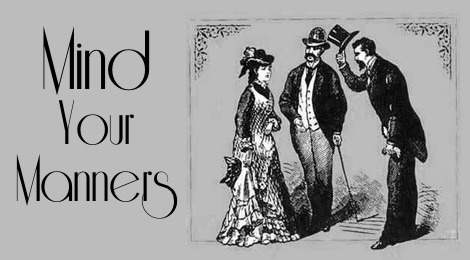Is etiquette just silly pretension taken to an extreme in the Victorian era? Is there universal etiquette? What about the etiquette in a martial arts school?
Where Are Your Manners?
Etiquette is a manner of social interaction, that's why it's sometimes called "manners". Modes of address, gestures including eye contact, eating rituals and clothing (such as when to remove hats and shoes) are usually elements of etiquette in most cultures, but each culture has different traditions.
I believe etiquette is a natural development in an intelligent population. That doesn't mean that it is a good thing, just that it is understandable. If you break protocol, it's because either you're not educated, or you're out of control. Valuing etiquette is the same as valuing education and willpower.
The dark side of manners is when proper conduct is used as a weapon to humiliate those of lower class or foreigners who are not familiar with the rules within a particular culture. To laugh at someone who doesn't know which fork to use is to assert dominance.
The Victorian Gentleman's Ideal
Here's some general quotes about comportment from various sources, gathered on a page called Mass Historia:
"Awkwardness of attitude betrays a want of good home training and physical culture. A man should not lounge in a chair, nurse his leg, caress his foot crossed over his knee or bite his nails. A gentleman is allowed more freedom than a lady. He may sit cross-legged if he wish, but should not sit with his knees far apart, nor with his foot on his knee. In indicating an object, move the whole hand, or the head, but never point the finger. All should be quiet and graceful, either in their sitting or standing position."
Rules of Etiquette and Home Culture, 1886
"A good manner is the best letter of recommendation among strangers. Civility, refinement and gentleness are passports to hearts and homes, while awkwardness, coarseness and gruffness are met with locked doors and closed hearts".
Our Deportment. 1881
"Never scratch your head, pick your teeth, clean your nails, or worse of all, pick your nose in company; all these things are disgusting. Spit as little as possible and never upon the floor.
If you are going into the presence of ladies, beware of onions, spirits and tobacco."
The Art of Good Behavior. 1845
"It is a great thing to be able to walk like a gentleman--that is, to get rid of that awkward, lounging, swinging gate of a clown and stop before you reach the affected and flippant step of the dandy. In short, nothing but being a gentleman can give you the air and step of one"
Martine's Handbook. 1866
"A gentleman never sits in the house with his hat on in the presence of ladies for a single moment. Indeed, so strong is the force of habit that a gentleman will quite unconsciously remove his hat on entering a parlor, or drawing room, even if there is no one present but himself. People who sit in the house with their hats on are to be suspected of having spent most of their time in bar rooms and similar places"
Martine's Handbook 1866
Links on Victorian etiquette:
http://www.logicmgmt.com/1876/etiquette/etiquette.htm
The Habits of Good Society: A Handbook for Ladies and Gentlemen
The Unclassified Laws of Etiquette
GoodReads: Popular Etiquette Books
The Eightfold Path of Etiquette
I find it interesting that Buddhism's Eightfold Path, a method to end suffering, follows very closely the Victorian rules of good conduct:
- Right View: Try to see all living things as suffering and deserving your compassion
- Right Intention: Avoid anger and your selfish desires
- Right Speech: Don't deliberately insult, lie, spread rumours. Silence is better than useless speech.
- Right Action: Don't kill, steal, or otherwise harm others
- Right Livelihood: Gain your livelihood in peaceful pursuits and improving the world
- Right Effort: Spend your energy in productive ways. Don't waste effort.
- Right Mindfulness: Think before speaking or acting.
- Right Concentration: Learn to focus on one thing at a time.
Salle/Dojo Etiquette
Jujitsu and the japanese tradition may be appropriate for bartitsu. What is traditional rules of conduct in a japanese martial arts school or dojo?
- Remove shoes before entering
- Bow before stepping onto the training floor and upon leaving
- Line up by order of seniority to bow before beginning class: one bow to the dojo or founder, one bow to your instructor
- Arrive to class on-time and ready to train: in your clean uniform (but you don't wash the obi or sash), fingernails trimmed and clean, paying attention
On the other hand, bartitsu is equally a European martial art, and we may need to look at the traditions within the "salle" or fencing academy:
- Before a bout, salute the other fencer with mask off. Salute after a bout, some say after each point.
- After a bout, remove mask and shake hands with an ungloved hand
In both of these martial and sporting situations, one is expected to wear a uniform and keep it clean. This is a matter of respect for the school, and the seriousness of your intention to train. It shows humility to submit your individual taste to the school's proscribed wardrobe. Finally, it promotes comeraderie among your fellow students.
Be Nice, Avoid Fights
One of our first tenets of practical fighting is to Avoidance. One of the best ways of avoiding a fight is politeness and manners. To understand what is expected in different circumstances will make you fit in. You won't be challenged to a duel if you never insult an honourable person by word or deed.
Ruffians do not expect curtesy, nor do they show any. This is why we train. Here's my paraphrase of a letter I once read, as the author was refusing a duel:
I have a sword to defend my honour. I have a stick to answer those without honour.
